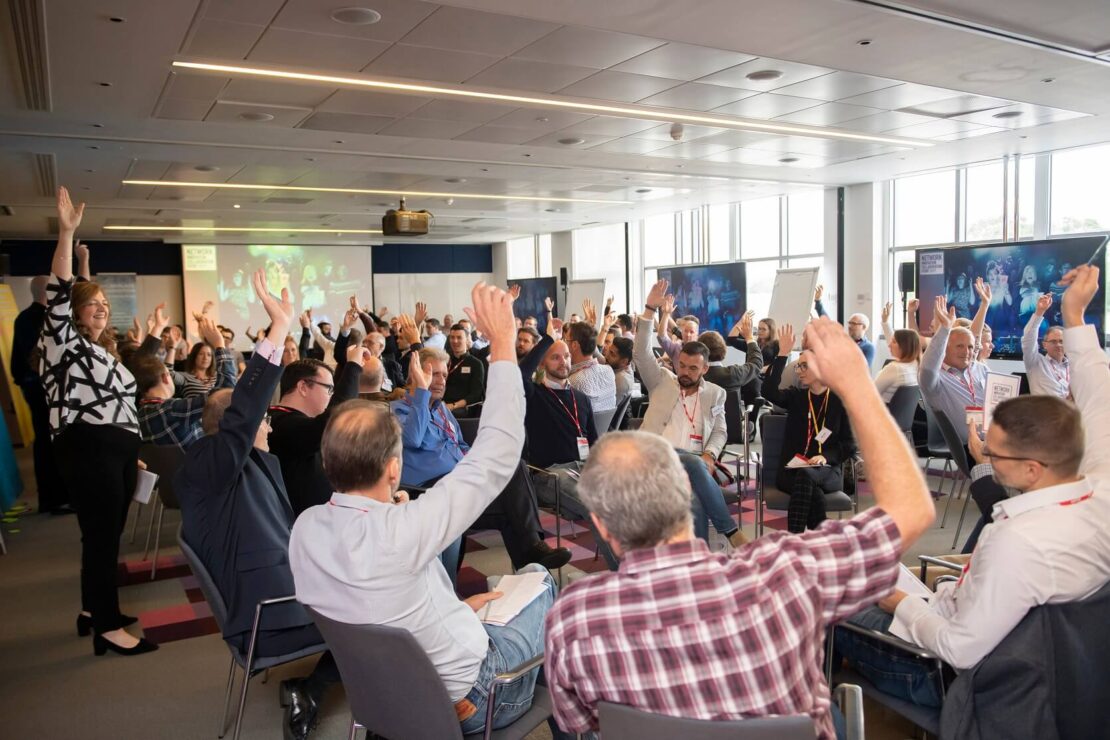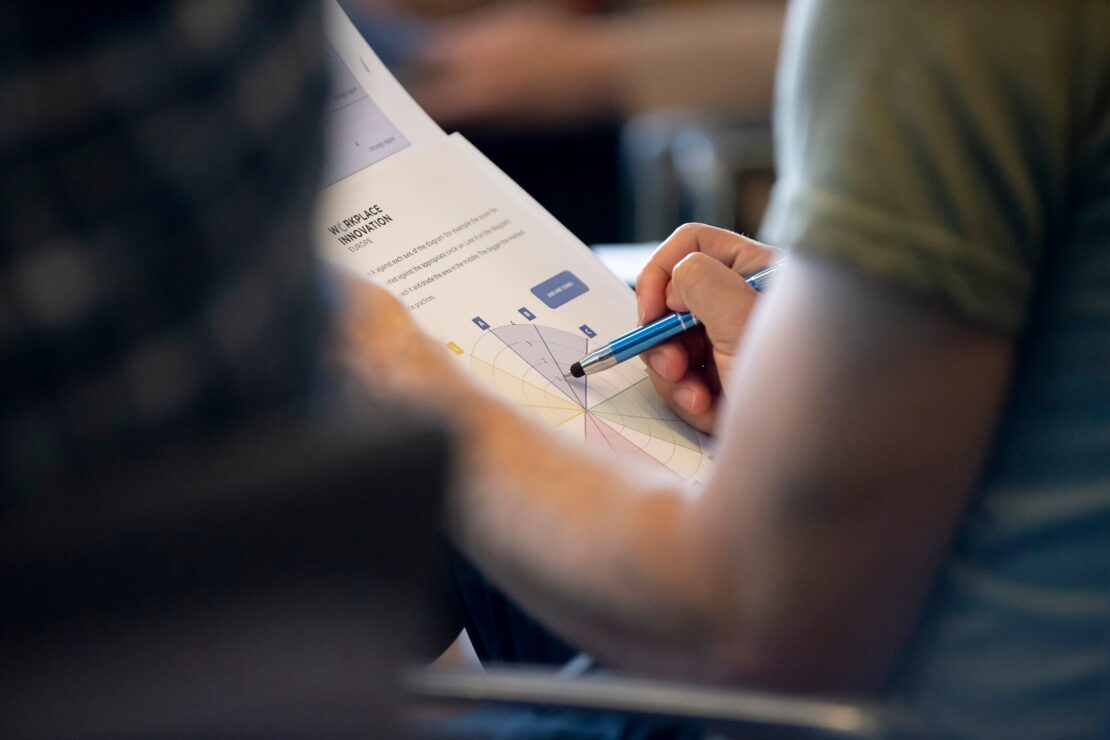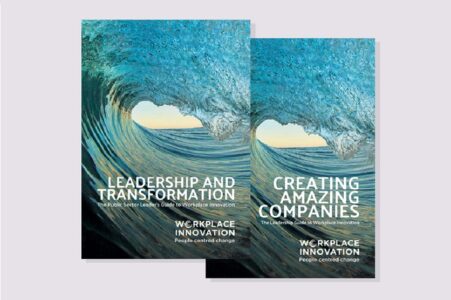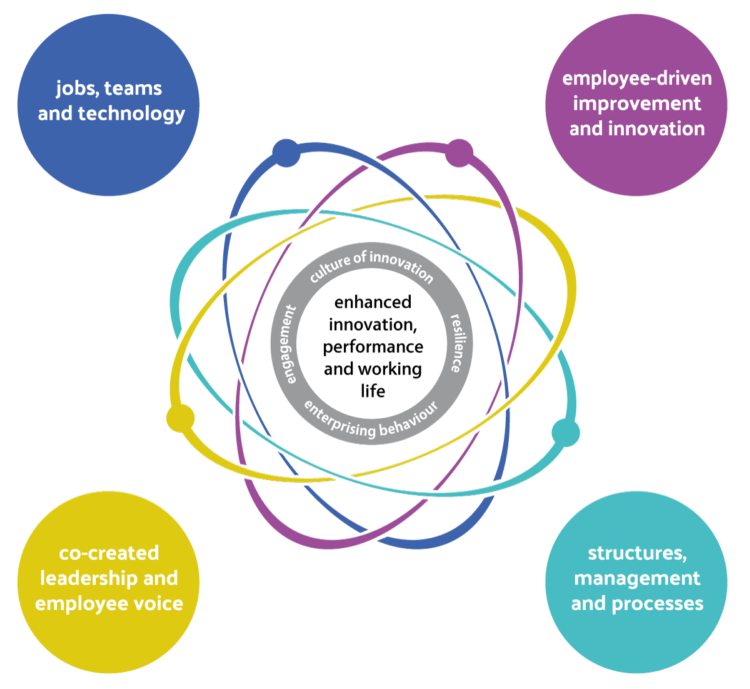What is Workplace Innovation?
As more people become aware of workplace innovation, the need to reach an agreed definition of its nature and scope is becoming critical. References to ‘workplace innovation(s)’ can be found in literature from the 1990s, generally referring to the introduction of any new forms of work organisation and any new forms of direct employee participation. Yet the concept has increasingly come to be understood in terms of specific workplace practices which are:
good job design,
self-managed teamworking,
human-centred technologies,
employee-driven improvement and innovation,
flatter organisational structures,
coaching styles of management,
trust-based systems and processes,
employee voice in decision-making,
co-created leadership.
These ten propositions define workplace innovation’s claim to be considered as a distinctive, robust yet practically-focused approach to organisational transformation.
- It is part of a strategic choice, running through the organisation’s entire business model and underpinned by a long-term vision and perspectives, sustainability and ethics.
- Its strongly associated with the simultaneous achievement of high performance and high quality of working life – and contributing to wider society.
- Workplace innovation is separate from – but builds on – ‘fair work’ principles such as job security, living wage, equality & diversity, and opportunities for training and education.
- Leadership styles, culture, engagement and job satisfaction are not independent but are largely determined by work organisation and the structure of management and control.
- Workplace innovation is focused on workplace practices grounded in substantial research and case study evidence.
- It is a systemic approach, recognising the interdependence of job autonomy, self-managed teamworking principles, skills-enhancing technologies, employee-driven innovation, flexible organisational structures, empowering systems, employee voice and co-created leadership.
- It’s based on high levels of employee involvement and empowerment, combining direct and representative participation.
- It is not a blueprint but comprises generic principles and practices to inspire fresh innovation in each organisation through inclusive dialogue, experimentation and learning.
- Workplace innovation is not a one-off. It introduces workplace practices and cultures that continually inspire and engage everyone to explore and discover better ways of doing things, harnessing creativity and talent from across the organisation.
- Workplace innovation doesn’t just change organisations – it changes the people who work in them, not least senior team members and managers. It is strongly associated with trust, accountability, curiosity, creativity, coaching behaviours and emotional intelligence, all of which grow with the workplace innovation journey.
Origins
In 2001, the European Commission requested a study designed to analyse evidence both from existing literature and from an international sample of over one hundred private and public sector organisations, each characterised by high performance and high quality of working life. Each placed a premium on employee participation and better utilisation of existing human talent, primarily by (re)designing the organisation of work and tasks to enable people to be more effective and creative. The aim of the Hi-Res study was to create a coherent, evidence-based and action-oriented framework aimed at company decision-makers as well as policymakers and researchers.
The Hi-Res report represents the first known attempt to define ‘workplace innovation’ in detail. It built on diverse traditions including both Socio-Technical Systems Design (Mohr & Van Amelsvoort, 2015) and Scandinavian Democratic Dialogue (Gustavsen, 1992).
Hi-Res summarised workplace innovation’s defining characteristic in terms of the creation of jobs and practices that “empower workers at every level of an organisation to use and develop their full range of knowledge, skills, experience and creativity in their day-to-day work”, leading to high performance simultaneously with high quality of working life.
Workplace Innovation brought practices such as job design and self-managed teams together with employee involvement in innovation, and representative participation in strategic decision-making. The concept highlights the ways in which these specific workplace practices connect skills development and skills utilisation, business performance, employee health, the retention of older workers, and economic and social inclusion.
To define workplace innovation it’s important to recognise both process and outcomes. The term describes the participatory process of innovation which leads to empowering workplace practices which, in turn, sustain continuing learning, reflection and innovation. Most importantly workplace innovation is an inherently social process, building skills and competence through creative collaboration. It builds bridges between the strategic knowledge of business leaders, the professional and tacit knowledge of frontline employees and the organisational design knowledge of experts, leading to self-sustaining processes of organisational development fuelled by learning and experimentation.
In recent years the concept of workplace innovation has been adopted by the European Commission, which launched the European Workplace Innovation Network (EUWIN) in 2013. A growing number of national and regional governments embrace workplace innovation as part of their policy platforms for productivity, innovation, skills and mental health and well-being. Trade unions in countries including Belgium, Denmark, Germany, Ireland and The Netherlands are becoming active proponents of workplace innovation as a means of improving the working lives of their members. Likewise, the recent publication of a landmark book, Workplace Innovation: Theory, Research and Practice (Oeij, Rus and Pot, 2017), attests to an expanding workplace innovation research community.
The Fifth Element
The task set by EU policymakers following the inauguration of EUWIN in 2013 was to create a coherent and accessible roadmap for the adoption of workplace innovation by companies and public sector organisations. ‘The Fifth Element’ was developed by Workplace Innovation Limited as co-leader of EUWIN to guide practitioners through workplace innovation and provide guidance on its implementation.
Expanding the original Hi-Res framework, The Fifth Element is grounded in an extensive analysis of articles and case studies. The analysis identified four bundles (or ‘Elements’) of working practices with a strong association between high performance and high quality of working life (see table below). Alignment between these Elements creates a synergy in the form of the ‘Fifth Element’, a system of mutually interdependent parts which leads to a sustainable culture of innovation and empowerment embedded throughout the organisation.
| Element | Indicative Practices | Associated Outcomes |
| Jobs, Teams & Technology | Individual discretion Job variety Constructive challenges Self-managed teams Collaboration within the team Reflective team practices People-centred technologies |
Improved workflow Enhanced quality Better productivity Cost reduction Engagement and retention Improved workforce health |
| Employee-Driven Innovation & Improvement | Productive reflection in teams Cross-team improvement groups Permission to experiment Company-wide innovation events |
Enhanced capacity for innovation & improvement Enterprising behaviour Enhanced quality & performance Learning & development Engagement & retention Intrinsic job satisfaction |
| Organisational Structures, Management and Procedures | Reduced hierarchies and silos Strengths-based career structure Coaching style line management Appraisals focused on learning and innovation Simplified procedures |
Improved workflow Cost reduction Better productivity Engagement & retention Improved workforce health |
| Co-Created Leadership & Employee Voice | Openness and transparency Emotionally intelligent behaviours Visible leadership Delegated decision-making Representative participation |
Strategic alignment Better decision-making Engagement and retention |
| The Fifth Element | Creating synergy through alignment between the four elements – a system of mutually reinforcing practices
A culture of empowerment and innovation |
Win-win outcomes for the organisation and its employees |
The Fifth Element was used as the interpretive structure for EUWIN’s Workplace Innovation Knowledge Bank. Further insights can also be found in Workplace Innovation Europe’s Guide to Workplace Innovation.
The Fifth Element was subsequently used by Workplace Innovation Europe CLG as the operational framework for delivering support to companies, both individually and through publicly-funded programmes in Scotland.
Contact Peter Totterdill for more information on workplace innovation
Gustavsen, B. (1992) Dialogue and Development: Theory of Communication, Action Research and the Restructuring of Working Life, Van Gorcum, Assen.
Mohr, B. J. & Van Amelsvoort, P. (Eds.) (2016). Co-Creating Humane and Innovative Organizations. Evolutions in the Practice of Socio-Technical System Design. Global STS-D Network Press.
Oeij, P.R.A., Rus, D. & Pot, F.D. (Eds.) (2017) “Workplace Innovation: Theory, Research and Practice”, volume in the ‘Aligning Perspectives on Health, Safety and Well-Being’ series. Cham: Springer.
Totterdill, P., Dhondt, S., & Milsome, S. (2002). Partners at Work? A Report to Europe’s Policymakers and Social Partners. The Hi-Res Report. Nottingham: The Work Institute. Available here.
Totterdill, P. (2015). Closing the Gap: ‘The Fifth Element’ and Workplace Innovation. European Journal of Workplace Innovation, 1(1), 55-74.
Read more
For companies

For policymakers

Guide to Workplace Innovation

Share This Story!

European Workplace Innovation Network (EUWIN)
EUWIN was established by the European Commission in 2013 and is now entirely supported by contributions from an international network of partners co-ordinated by HIVA (University of Leuven). EUWIN also functions as a network partner to BEYOND4.0 and BRIDGES5.0 projects.
Contact: Workplace Innovation Europe CLG (contact@workplaceinnovation.eu).
